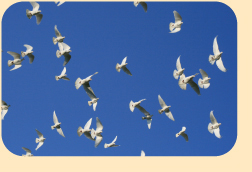Middle School
 Many animals make the journey every year between winter food sources and summer breeding grounds. This pattern of regular movement is called migration
Many animals make the journey every year between winter food sources and summer breeding grounds. This pattern of regular movement is called migration.
Birds are some of the most well-known migrants in the animal kingdom. A bird also holds the record for the longest regular migration route – the arctic tern migrates every year from its Arctic breeding grounds to its Antarctic feeding grounds. The round-trip is roughly 45,000 miles. The “average” arctic tern will journey the
distance from the earth to the moon in its lifetime, or approximately
500,000 miles!
Most migrating animals do not have such an extreme route, but many of the birds in our own backyards undertake the journey from North America to Central and South America every year. In the U.S., migrants often follow one of four “flyways” that stretch from Canada to Panama. These highways in the sky do not observe strict boundaries but generally follow major landmarks, including coastlines, mountain ranges, and rivers.
Have each student choose and research a migrating species of bird. They should locate the bird’s summer and winter grounds, their approximate migration route, and any important features or stops along the way. How many countries does your bird fly through? How long does it take their bird to travel? What hazards would they face along the way? What kind of habitat does your bird require?
Students can then write a journal or short story from the migrant’s perspective to describe the journey that their bird makes every year! If possible, chart the routes of the students’ birds on a communal map, along with pictures of the birds!

